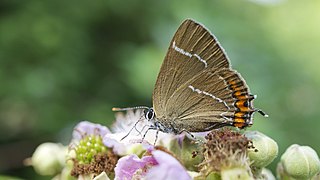
The white-letter hairstreak is a butterfly in the family Lycaenidae.

The genus Satyrium contains butterflies in the family Lycaenidae. The species of this genus are found in the Holarctic ecozone. For distribution information see Further reading "Le genre Satyrium".

Satyrium spini, the blue spot hairstreak, is a butterfly in the family Lycaenidae.

Satyrium esculi, the false ilex hairstreak, is a butterfly in the family Lycaenidae. The species was first described by Jacob Hübner in 1804.

Satyrium calanus, the banded hairstreak, is a butterfly in the family Lycaenidae.

Satyrium edwardsii, the Edwards' hairstreak, is a species of butterfly in the family Lycaenidae. It is found in the eastern parts of the United States and in the southern parts of the Canadian provinces from Saskatchewan to Quebec.

Satyrium favonius, the oak hairstreak or southern hairstreak, is a butterfly of the family Lycaenidae. It is found in the United States from southern New England and the Atlantic Coast south to peninsular Florida and west to central Illinois, south-eastern Colorado and the Gulf Coast.

Satyrium behrii, the Behr's hairstreak, is a butterfly of the family Lycaenidae. It is found in western North America from western Texas north and west through New Mexico, Arizona, and southern California to British Columbia.

Satyrium fuliginosum, the sooty hairstreak, is a butterfly of the family Lycaenidae. It is found in western North America from British Columbia to central California, east to Wyoming and northern Colorado.

The Sylvan Hairstreak is a butterfly of the family Lycaenidae. It is found in western North America, from British Columbia south-east to Wyoming, Colorado and New Mexico and south through California to Baja California Norte.

Satyrium liparops, the striped hairstreak, is a butterfly of the family Lycaenidae described by John Eatton Le Conte in 1833. It is found in North America, from the Rocky Mountains south from southern Canada to Colorado, east to Maine and south to Florida.

Satyrium semiluna, known generally as the sagebrush sooty hairstreak or half-moon hairstreak, is a species of hairstreak in the butterfly family Lycaenidae. It is found in North America. The MONA or Hodges number for Satyrium semiluna is 4277.1.

Satyrium caryaevorus, the hickory hairstreak, is a butterfly of the family Lycaenidae. It is found in eastern North America, from southern Ontario west to Minnesota and Iowa, south in the Appalachian Mountains to eastern Tennessee.
Satyrium kingi, or King's hairstreak, is a species of hairstreak in the butterfly family Lycaenidae.















